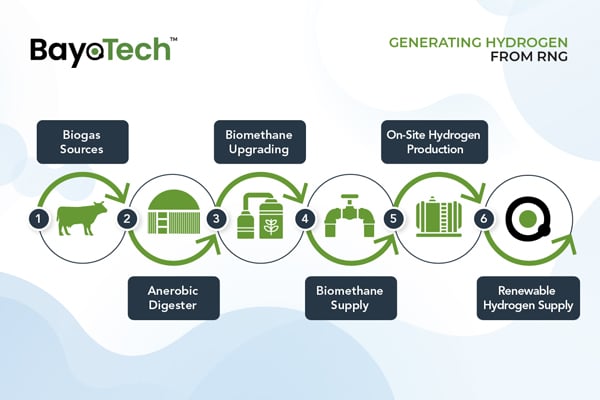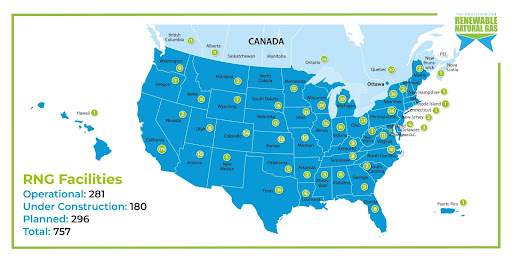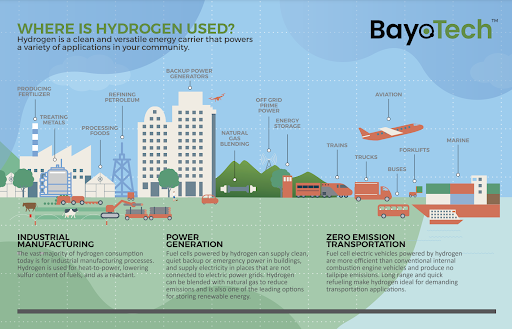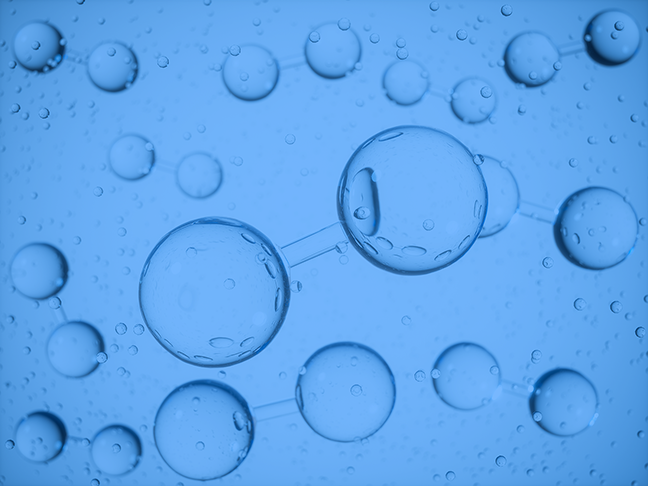How Is Hydrogen Currently Produced?
Hydrogen shows enormous promise as a fuel for shipping and transportation. But to be pollution and carbon-free, hydrogen for fuel cells must come from renewable energy.
Natural gas reforming, or Steam Methane Reforming, produces hydrogen from the methane in natural gas. It’s the primary source of the world’s current hydrogen production, accounting for around three quarters of the 70 million tonnes of hydrogen produced annually and 6% of global natural gas consumption.
Which means that, while hydrogen consumed in fuel cells is emission-free at the tailpipe (producing only water), the most common method of making that hydrogen is not yet carbon-free. Cleaner alternatives to natural gas reforming exist. Hydrogen can be produced by splitting water molecules with nuclear energy and by using renewable energy sources such as wind, solar, geothermal, and hydro-electric power. However, these methods come with higher production costs, making adoption of carbon-free hydrogen more difficult.
One viable solution is the production of hydrogen from renewable natural gas or biogas. This approach can significantly reduce greenhouse gas emissions and minimize environmental pollution.
What Is Renewable Natural Gas?
Renewable natural gas (RNG) is a type of biogas produced through anaerobic digestion, whereby organic matter is broken down in an oxygen-free environment. Microorganisms consume the organic matter and convert it to natural gas. Sources of organic matter include manure from dairy farms or swine operations, municipal wastewater, food waste, and solid waste landfills. By-products from biofuel production, energy crops and agricultural residues can also be used to produce RNG.
RNG from Farms
Cows are infamous for producing methane, which is 25 more times potent as a greenhouse gas than carbon dioxide. It’s estimated that cows generate 40% of the world’s methane emissions. One solution is to process animal manure through anaerobic-manure digester systems to produce carbon negative RNG. The process helps farms save on waste disposal costs while generating revenue. Some farms are partnering with companies that specialize in addressing waste issues in agriculture to receive funding and solve waste disposal problems.
The Goodrich family farm in Vermont provides an interesting case study for converting methane to RNG. According to an article in Progressive Dairy, the farm’s 900 cows produce methane at an extraordinary rate. Recognizing the harm their animals posed to the environment, the Goodrich’s contracted with Vanguard Renewables, a company that develops systems to solve waste disposal issues.
By leasing Goodrich’s property, providing an extra source of income for the family, Vanguard built an anaerobic manure-digestion system on site. This system has allowed the family farm to pipe RNG directly up the road to a local school where it provides 100% of the school’s thermal needs.
Besides keeping methane from getting into atmosphere, using waste streams for RNG has other advantages, including:
- Reducing the amount of waste that would otherwise be disposed of in ways that are not environmentally beneficial.
- Anaerobic digestion produces valuable by-products, such as fertilizer and industrial chemicals and polymers.
RNG has a huge potential. In 2020, the U.S. produced an estimated 59 billion Btu of RNG. By 2030, the Coalition for Renewable Natural Gas estimates U.S. RNG production will be 7X the levels of 2020, or 413 billion Btu. By 2050, the Coalition estimates the U.S. will produce 27X the 2020 levels of RNG or 1.6 billion Btu.
According to a 2022 report by Amaresco, existing organic waste streams are sufficient to produce enough RNG to replace up to 7 percent of the fossil gas consumed in the U.S. Studies show that RNG has the potential to supply 30% of the total natural gas supply by 2040.
How Is Hydrogen Made From RNG?
Hydrogen can be produced from the methane in RNG using steam methane reformation (SMR), which currently produces most of the world’s hydrogen. Hydrogen production from RNG works in the same way as fossil natural gas. However, using RNG feedstock in the SMR process instead of fossil natural gas results in low carbon, carbon neutral, or even carbon negative hydrogen.

What is the Current Viability of RNG?
As for viability, RNG currently costs more than traditional fossil gas. But hydrogen consumers don’t have to use 100% RNG to make a significant carbon difference. RNG can be blended with fossil gas, and even 30% RNG in the mix allows users to reach zero carbon intensity hydrogen (depending on the source of the RNG). The greater the blend of RNG, the lower the carbon intensity.
How Does Hydrogen from RNG Compare With Diesel for Cost?
The Inflation Reduction Act (IRA), signed into law by President Biden on August 16, 2022, authorized $391 billion in spending on energy and climate change as part of a $738 billion overall package. The IRA includes Production Tax Credits (PTCs) to narrow the cost gap between diesel and hydrogen to accelerate the transition and make it viable. With PTCs, the net price of hydrogen approaches parity with the current cost of diesel. The lower costs encourage hydrogen use, driving the price down further through increased competition and overall supply.
We know from feedback that many customers are starting to look for carbon neutral or even carbon negative hydrogen. In the context of their broader sustainability portfolio, if the pricing makes sense, they’ll make that transition. So BayoTech has developed two hydrogen products that qualify for the IRA PTC by employing blends of RNG. One is BayoGreen, a low carbon hydrogen produced by fueling BayoTech’s SMR system with a specified blend of RNG, optimized to customer needs. The other is BayoZero, which is carbon neutral hydrogen using up to thirty percent RNG. With IRA PTC both products approach cost-parity with diesel.
How is Bayotech Incorporating RNG into its Existing Production Stream?
In an ideal world, BayoTech’s hydrogen production streams would be located near RNG producers, allowing us to source RNG directly from that facility. But that’s rarely the case. To solve this issue, BayoTech buys PTCs using “book and claim,” an accounting mechanism that takes environmental attributes (or carbon credits) associated with the RNG in one location, accounting for how much RNG that location produces, and selling those credits to users who need that resource in another location. It drives down the cost of clean hydrogen production.
The resulting environmental benefits are essentially the same, and they provide geographic flexibility for both upstream and downstream market participants. Benefits can extend across states, or even internationally between Canada and the U.S.
Conclusion
Currently, most hydrogen is produced from natural gas, which contributes to carbon emissions. A viable solution is to make hydrogen from RNG made from organic waste. When this material decomposes, it emits methane, which is a potent greenhouse gas. By capturing that methane and converting it to hydrogen, we can prevent it from escaping into the atmosphere and contributing to climate change. Blending RNG with fossil gas significantly reduces emissions and keeps production costs low. As the cost gap between diesel and hydrogen narrows with the implementation of the IRA PTC, hydrogen fuel has the potential to become fully sustainable and reach zero emissions as soon as possible.






